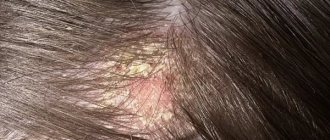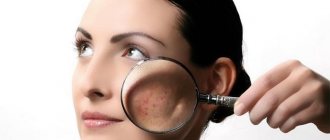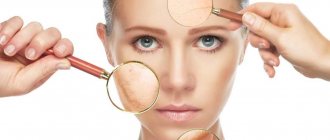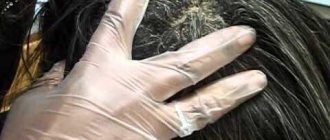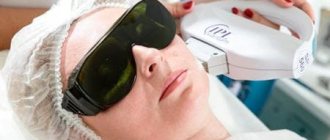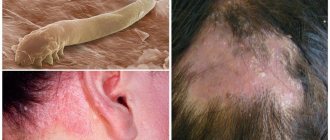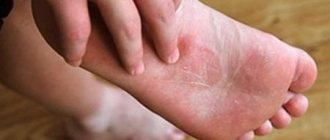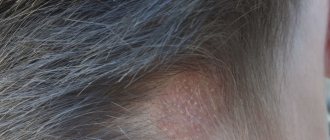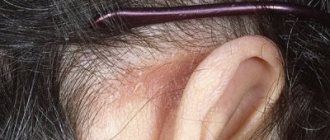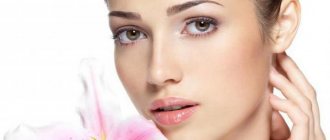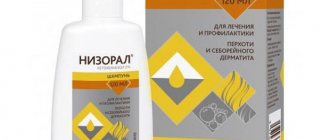09.02.2017
Seborrheic dermatitis is characterized by insufficient functioning of the sebaceous glands. Due to the fact that sebum is not produced in the required quantity, the skin dries out, begins to peel, and large amounts of dandruff appear on the head.
There are many reasons why dry seborrhea occurs - from the wrong shampoo to hormonal changes in the body, unbalanced nutrition, fungal infections, stress or diseases of internal organs.
Most cases of dry seborrhea are diagnosed in children; rarely the disease affects adults. The causes of the disease may be age-related characteristics of the body, atmospheric factors, improper skin and hair care.
Dry seborrhea is provoked by reduced immunity, unbalanced nutrition, and excessive exercise. Another factor that provokes the disease is the yeast-like fungi Pityrosporum Ovale and Malassezia Furfur. In a healthy body, these fungi are always present on human skin. They feed on the secretion of the sebaceous glands. With a decrease in immunity, the growth of fungal colonies begins sharply.
Among the main symptoms of seborrhea, abundant small dandruff is noted, the skin cracks and gives a feeling of “tightness”. Hair loses its shine, becomes brittle and thin, and ends split. Patients may experience burning and itching. In severe forms, baldness is possible.
Diagnosis of the disease is carried out by specialists. This could be: a neurologist, endocrinologist, dermatologist, gynecologist. A clear picture is needed to make a diagnosis. The doctor collects anamnesis, suggests the causes of the disease, and sends for a biochemical blood test. Blood is also donated for hormones, skin and hair are examined in the laboratory, scrapings are taken from the affected areas of the skin, and in some cases an ultrasound of the abdominal organs is prescribed.
Causes and risk groups
There are three types of seborrheic dermatitis: oily, dry and mixed. But the reason is always the same: disruption of the sebaceous glands. With dry seborrhea, the sebaceous glands do not produce sebum in the required quantities, most often due to blockage of the passages by yeast-like fungi.
But sometimes - for example, in adolescents during puberty - seborrhea is physiological in nature. That is, it refers to temporary phenomena and goes away on its own. If the patient has long left adolescence, attention should be paid to the following provoking factors:
- lack of vitamins;
- increased blood glucose levels;
- unbalanced diet;
- dysfunctions of the digestive organs;
- nervous disorders;
- high levels of androgen hormones;
- schizophrenia and other mental illnesses;
- epilepsy;
- long-term therapy with certain medications (corticosteroids, vitamin H).
If there is at least one provoking factor, a person is placed at risk: a small push is enough for dry seborrhea to manifest itself.
Seborrhea and its dry type
Seborrhea is a dermatological disease manifested by disruption of the sebaceous glands of the scalp and facial skin. Literally, the name of the disease is translated as sebum secretion, which fully reflects the essence of the problem. This disease has several types:
- oily - excessive production of sebum by the sebaceous glands, which leads to constantly shiny hair, which cannot be gotten rid of by simply washing your hair;
- dry - insufficient production of sebum, leading to drying out, causing the skin to peel, dandruff to appear, and hairs to split, become brittle and dull;
- mixed is a type of disease that has both dry and oily type symptoms with excessive sebum production and flakes of exfoliated dead skin.
The dry type is the most widespread and is popularly called dandruff, although dandruff itself is a symptom that should be considered as one of the manifestations of a dermatological phenomenon.
As a rule, a problem arises against the background of reduced local immunity of various etiologies (origins). In advanced cases, the disease may be accompanied by decreased hair growth, a decrease in natural hair length, as well as fragmented alopecia.
Dry seborrhea is a consequence of insufficient sebum production due to infection of the glands by a fungal agent.
Symptoms
The most important symptom of a skin disease is fine and dry dandruff covering the scalp and hair. The scales are easily blown off and are noticeable on the patient’s clothing and personal belongings. Other signs of dry seborrheic dermatitis:
- dryness and tightness of the skin, cracks and peeling;
- severe itching, discomfort;
- red spots on the skin;
- hair loss, bald spots.
Seborrhea can be severe or mild, sometimes the symptoms decrease on their own, then return again. In any case, the manifestations of the disease are not the most pleasant or aesthetic. Therefore, it is not recommended to let the process take its course, especially since today there are a huge number of effective methods of combating seborrhea in addition to classic advertised shampoos.
Darsonvalization
Treatment of hair and scalp with the Darsonval apparatus should be especially highlighted. It is used both during and after completion of treatment for dry seborrheic dermatitis.
With the help of darsonvalization you can:
- regulate the functioning of the sebaceous glands of the scalp;
- get rid of dandruff;
- strengthen hair follicles;
- improve blood supply to hair roots and enhance their growth.
The recommended course of treatment is at least 20 procedures, each of which takes about 10-15 minutes. The procedure can be obtained at a beauty salon or physiotherapy office. It is also possible to purchase a home version of the device.
Darsonvalization has a lot of good reviews. It has been used in medicine for about 100 years. The positive effect is achieved due to the fact that the device enhances the outflow of lymph and blood, as a result of which metabolic processes in the tissues are accelerated.
Darsonvalization is prohibited for certain categories of people:
- cancer patients;
- pregnant and lactating women;
- people with cardiovascular diseases.
Diagnostics
Why is it needed at all, if you can really buy a fashionable shampoo and forget about the problem? In fact, cosmetics, even if they are sold in a pharmacy, do not solve the problem because they do not eliminate the real cause of the disease. The shampoo or mask will not affect hormone levels or stomach function. That's why you should consult a dermatologist and undergo all the necessary tests. Believe me, it will be faster, safer and cheaper than trying on yourself one after another all the products from the assortment of supermarkets, pharmacies, online stores and grandmother’s reference books on traditional medicine.
So, in order to accurately diagnose dry seborrhea and determine the causes that caused it, the following measures will be required:
- Consultation with a doctor. To take a history - the more the doctor knows about you and your health, the easier it will be to choose adequate treatment.
- General blood test.
- Blood test for hormones.
- Examination of skin and hair scrapings.
- Ultrasound of the thyroid gland, digestive organs (if necessary).
In modern medical institutions, a complete examination can be completed in one day and test results can be obtained within a maximum of 48 hours.
Symptoms
Symptoms of dry seborrhea
Dry seborrhea of the scalp or face has various clinical manifestations. In the first case, complaints often arise about:
- the appearance of fine dandruff;
- thinning, increased fragility and loss of shine of hair;
- severe itching and burning of the scalp;
- excessive hair loss;
- sleep disturbance;
- decreased salivation;
- the appearance of light yellowish scales on the head;
- formation of red spots and irritation;
- emotional disorders.
The main symptoms of seborrhea on the face are:
- feeling of “tightness” of the skin;
- thinning of the skin, which makes it very easy to break its integrity - because of this, secondary inflammatory and purulent processes often occur;
- cracking and peeling of the skin;
- frequent mood changes;
- itching and burning;
- the appearance of red or pink spots;
- skin rash of unknown etiology;
- slight deterioration in general health.
It is worth noting that if dry seborrhea was formed against the background of some other illness, then the above symptomatic picture will also include the most characteristic signs of the underlying disease.
Treatment of dry seborrhea
Treatment in this case is aimed at eliminating the external manifestations of seborrhea, normalizing the functions of the sebaceous glands and eliminating the root cause of the disease. To do this, the doctor will draw up a regimen that includes a course of medications, vitamin supplements, as well as physiotherapeutic procedures. If desired, complex therapy can be supplemented with folk remedies for seborrheic dermatitis.
Medication
Depending on the cause of the disease, the doctor will recommend hormones, antifungal drugs, antihistamines, vitamins, hair strengthening or immunomodulatory drugs.
Hormonal, immunomodulators
Hormonal remedies for dry seborrhea of the scalp are prescribed only by a doctor - these are serious drugs that have a number of contraindications and give side effects even when the dosages are strictly observed. Therefore, medical supervision during hormone therapy is necessary.
Antifungal drugs
As a rule, these are a variety of shampoos, balms and lotions, ointments and solutions for external use. “Sulsena” is a relatively inexpensive and effective drug based on selenium sulfate, which helps get rid of not only fungus, but also hair loss. The drug “Sebopirox-911”, shampoo “Fetoval” or “Nizoral” have also proven themselves well.
The simplest and most affordable remedies from your home medicine cabinet will help you effectively fight the fungus - boric or salicylic acid, sulfur ointment, zinc, salicylic or naphthalonic acid. The product is rubbed into the scalp daily and washed off after half an hour with medicated shampoo.
Antimycotics in tablets are prescribed only for severe forms of the disease or if the fungus also affects other organs.
Keratolytic drugs
“Kombutek” or “Pyrogenal” products stop hair loss, restore its structure, normalize the fat balance of the scalp, relieve itching and a feeling of skin tightness by stimulating blood circulation and metabolic processes.
Vitamin complexes
The emphasis is on vitamins A, E, B and D. You can take them all separately. But it is much more convenient to choose one of the popular complexes with an already balanced composition - “Duovit”, “Vitrum” or “AEVit”. Brewer's yeast will help solve problems with the scalp and face. The course of vitamin therapy lasts at least 3 months.
Folk remedies for seborrheic dermatitis on the head
How to treat seborrheic dermatitis on the head besides medications? Traditional medicine has various remedies that successfully cope with inflammatory processes, relieving itching and relieving the skin of discomfort. Treatment of seborrheic dermatitis on the head with folk remedies does not exclude the use of medications, but is done together, complementing each other.
Essential oils and various medicinal herbs are used in treatment. Birch tar, which has excellent anti-inflammatory properties, is often used to get rid of seborrhea. Herbal remedies relieve skin irritation by drying out the crusts. Various means - masks, lotions, all kinds of applications and rubbing - will help defeat the disease.
Hair mask for seborrheic dermatitis
It is important to understand what kind of seborrhea has affected the skin, and to build on this when preparing medicinal formulations. A hair mask for seborrheic dermatitis using onions is perfect for the oily form of the disease. To do this take:
- burdock oil – 1 tbsp. l.;
- mustard powder – 1 tsp;
- chicken egg yolk – 1 pc.;
- honey – 1 tsp;
- onion – 1 pc.
Dilute mustard powder with water until it becomes thick sour cream. Grind the honey with the yolk and add burdock oil. Squeeze the juice from the onion and add it to the prepared mixture. Mix everything thoroughly again until a homogeneous mass is formed in the container. There is no need to wash your hair before using the mask. Apply the mixture to the roots and keep under polyethylene for half an hour. After the procedure, hair should be washed with sulfate-free shampoo.
For dry seborrhea, you can use the following recipe:
- banana – 1 pc.;
- salt – 2 tbsp. l.
Grind an overripe banana - the one with black skin - in a blender together with the peel. Add salt and mix everything. Wash your hair and apply the mask for half an hour. At the end of the procedure, rinse your hair with warm water.
- Canned corn salad: simple recipes
- Permanent eyebrow makeup hair technique
- How to treat trophic ulcers on the legs with folk remedies
Soda for seborrhea of the scalp
It is known that soda is often used for seborrhea of the scalp. This substance does a good job of fighting disease on the scalp. We must remember that when treating a disease, you must first find the root cause of seborrhea. One of the effective ways to use soda is a recipe according to which, to prepare the composition, one spoon of the substance is dissolved in a liter of boiled water and poured over the hair before washing.
Features of treatment on the face
If seborrheic dermatitis spreads to the skin of the face, shoulders and chest, then the priority is ointments, gels and lotions that have both an antibacterial and softening effect. The use of alcohol solutions is not recommended. They disinfect well, but at the same time dry out the skin.
It is very important during the treatment period not to use concealing cosmetics - foundations and powders, concealers, special pencils. For washing, it is better to use melted or boiled water, or decoctions of medicinal herbs. After this, the skin is carefully blotted with a napkin, then therapeutic masks and creams are worn.
Dosed ultraviolet irradiation will help get rid of dry seborrhea. But prolonged exposure to the sun is prohibited. You can learn more about seborrhea on the face from this article.
Physiotherapy for dry seborrhea
Modern physical procedures are usually painless and completely safe, but they must be performed by a qualified doctor in a well-equipped office.
Cryomassage
Exposure to extremely low temperatures helps effectively fight fungus. The affected areas of the skin are treated with a special device with a nozzle through which liquid nitrogen or a mixture of nitrogen and air is released in the form of steam. The standard course consists of 10 procedures. Not used if the patient is hypersensitive to cold.
Laser therapy
A directed laser beam of medium intensity is used. The areas are treated point-by-point; if the procedure is performed by a professional, no complications in the form of burns or irritations should arise. This method is not used for inflammatory processes of any organ, as well as for violations of the integrity of the skin.
Local darsonvalization
Darsonvalization is the treatment of the skin with high-frequency current. This is mainly how acne and pigmentation are treated, but for seborrhea of the face and body, this method also gives good results. With darsonvalization, blood circulation in the skin cells is activated and metabolism improves. But this procedure has a number of contraindications, the most serious being any skin tumors, even benign ones.
Methods of therapy
Treatment for dry seborrhea of the scalp involves the patient taking medications. Patients are also prescribed special shampoos. On the recommendation of a doctor, the main treatment is supplemented with physiotherapy sessions and the use of folk remedies. Special attention should be paid to the patient's compliance with a special diet.
Medicines
It is recommended to treat dry seborrhea with the following drugs:
- antifungals in the form of tablets (“Fluconazole”, “Ketoconazole”);
- immune stimulants (“Cycloferon”);
- antimycotics in the form of external agents and antibacterial ointments (“Cinovit”, “Exoderil”);
- vitamin complexes, including a combination of vitamins C, B, A, E, D.
For example, these vitamins have good reviews for dry seborrhea.
They are inexpensive (about 60 rubles). Before taking, you should consult a specialist. Hydrocortisone ointments may be prescribed to restore hormonal balance.
Shampoos
During treatment, it is necessary to use special hair washing products. Shampoo for dry seborrhea of the scalp should be purchased exclusively in pharmacies and contain over 2% of active medicinal ingredients.
Be sure to read:
Effective methods for treating oily seborrhea of the scalp
During therapy, the following types of shampoos are prescribed:
- containing ketoconazole (“Nizoral”);
- including zinc pyrithione (“Keto-plus”);
- containing ciclopirox (“Sebipirox”);
- with zinc (“Zincon”);
- regenerating with selenium sulfide (“Sulsena”).
Medicinal shampoos are used for several months at least twice a week. They treat both the scalp and hair roots.
Physiotherapy
In case of illness, physiotherapy is used as an additional treatment method. Patients undergo cryomassage where the sore scalp is exposed to vapors containing liquid nitrogen.
of darsonvalization may also be prescribed . During the procedure, a high frequency current is applied to the scalp through a device with glass electrodes.
If necessary, patients undergo courses of ultraviolet irradiation . Ozone therapy may be prescribed .
Diet
If you have seborrhea, smoked products should be completely excluded from your diet. It is also necessary to reduce the consumption of fatty and fried foods. During treatment you should not use hot spices.
The diet should include more vegetables and fruits (cabbage, leeks, citrus fruits, salad). It is necessary to eat protein foods (eggs and lean meat) more often. You should also include buckwheat porridge and fish in the menu.
Folk remedies
Treatment of dry seborrhea of the scalp with folk remedies is allowed only on the recommendation of a doctor. Patients can use the following recipes:
- 6% apple cider vinegar. 4 large spoons of the solution are added to a glass of water. The mixture is stirred. It must be used after every hair wash. The solution should be used to thoroughly rinse the hair roots and scalp itself.
- A mixture of burdock oil and tea tree. Take 110 ml of the first and 3 drops of the second component. Everything is mixed thoroughly. The resulting mixture must be rubbed into the scalp 1.5 hours before each shampoo.
- A mixture of oak bark and honey. Take 30 g of dry ground bark. The mixture is poured with 2 cups of boiling water and placed in a water bath for 5 minutes. Then two large spoons of honey are added to the mixture. The mass is cooled and rubbed into the scalp, after which it is washed off with shampoo after an hour. The product has an antipruritic effect and also relieves inflammation.
Be sure to read:
Effective methods for treating oily seborrhea of the scalp
Castor oil can be used. The scalp can also be washed with tar soap.
Traditional methods of treatment
Honey, soda, salt - all these are proven and affordable folk remedies against seborrhea of the scalp, face and body. To prepare medicines, any vegetable oil is used as a basis - sea buckthorn, olive, burdock, flaxseed. The oil is heated in a water bath, combined with a spoon of honey, salt or soda, rubbed into the scalp, wrapped warmly and left for about an hour. Then the hair should be washed several times with warm water and medicated shampoo and rinsed with a decoction of medicinal herbs. In this case, decoctions of nettle, violet, and parsley will be useful.
Causes
The causative agents of the disease in humans are yeast fungi belonging to the genus Pityrosporum ovale. Microorganisms are classified as opportunistic pathogens, since under normal conditions they live on the skin of all people. In the presence of a wide range of provoking factors, their uncontrolled reproduction occurs, which leads to the development of dry seborrhea.
There are both physiological and pathological causes of this disease.
Physiological ones include:
- neglect of personal hygiene in terms of improper hair care;
- the use of detergents that are aggressive to the skin;
- frequent stress and overexertion;
- unfavorable environment;
- poor nutrition with a predominance of fatty, smoked, sweet and spicy foods in the diet;
- excessive alcohol consumption;
- smoking;
- frequent use of medications;
- decreased immune defense of the body.
Seborrheic dermatitis of the dry scalp can occur due to hormonal changes in the body . It is especially common among teenagers and women over 40 years of age. A possible physiological cause of the disease is also natural changes in the endocrine system in a woman during pregnancy.
Features of treatment in children
Seborrheic dermatitis in infants is best treated with gentle folk remedies. A child’s skin is much more sensitive than an adult’s; local immunity has not yet been formed, so aggressive agents can, in addition to seborrhea, cause allergic irritation.
The main actions are rather preventative. The child’s diet should be adjusted - exclude sweets and chocolate, all potential allergens (cocoa, citrus fruits, strawberries), fatty and fried foods. 2-3 times a week you need to bathe the child and wash his hair with decoctions of medicinal herbs. Then an antifungal cream or zinc ointment is applied. Complex treatment is complemented by walks in the fresh air and taking immunomodulatory drugs (selected by a pediatrician).
Causes of seborrheic dermatitis
At the moment, experts cannot say what exactly causes seborrheic dermatitis. Often the main risk factor is associated with heredity, which is complemented by symptoms of the disease. Modern medicine has a fairly wide list of symptoms, which are characterized by different courses.
The main reason that causes seborrheic dermatitis in infants is the activity of the sebaceous glands , which is further reinforced by maternal androgens. The sebaceous glands in young people and adolescents tend to restore their level of activity when interacting with endogenous androgen.
In conditions of the development of seborrhea, often the amount of synthesized sebaceous secretion does not reach the normal level. Such epidermis contains a reduced amount of free fatty acids, which fully applies to squalene and paraffin esters.
Compared to the listed substances, the body contains slightly higher amounts of triglycerides and cholesterol.
Experts have made attempts to understand what effect the activity of yeasts and bacteria has on the development of the disease. Unfortunately, the research ended inconclusively. It is clearly seen that seborrheic dermatitis is directly associated with a secondary bacterial infection. In addition to this, experts do not yet have information confirming the autoimmune mechanism of the disease. In most cases, seborrhea is provoked due to stress factors.
Risk factors
The body of any person contains the fungus malassezia furfur. However, the disease develops only in a certain group of people. In order for the fungus to begin its activity and begin to multiply, certain conditions must be provided:
- malnutrition;
- bad habits;
- hereditary components of sebum;
- features of hormonal changes.
The creation of such conditions has a negative impact on the vital functions of the body, but for the fungus such an environment is favorable. In such conditions, it develops, grows , and after some time seborrhea occurs. At a young age, an increased level of hormonal levels is observed in the body; the sebaceous glands, through their activity, have a significant impact on the health of the body, as a result, the risk of contracting this disease increases.
Treatment prognosis
Seborrhea is a non-life-threatening dermatological disease. But many cannot get rid of it for years only for the reason that they do not take it seriously enough, do not try to establish and eliminate its cause, but only fight external manifestations with improvised means and methods. If you are treated consistently and comprehensively, with the support of a good dermatologist, you can completely get rid of unpleasant symptoms in a few weeks. Otherwise, dry seborrhea can lead to noticeable baldness in a matter of months.
Why on the head?
The provocateur of seborrheic dermatitis is the fungus Malassezia furfur. This microbe is always present in the stratum corneum of the skin. Makes up 40% of the total number of microorganisms on the hairy areas of the body. When the fungal concentration exceeds 60%, the process of keratinization and detachment of skin scales changes. They accumulate on the surface of the dermis, disrupting cellular respiration, causing accelerated skin contamination. The particles look like dandruff. The waste products of the fungus cause skin itching. The lack of protective secretions leads to the penetration of infection into microdamages. This is how inflammation develops in the affected areas, which is inherent in any of the dermatitis.
What to do if you have dermatitis?!
|
Malassezia furfur is a fungus that lives in the stratum corneum of the skin.
The provoking fungus lives between skin particles and also in hair follicles. During the reproduction process, the fungus feeds on lard and keratin. Releases toxic waste products.
There are more sebaceous glands on the head, so the disease in most cases affects this part of the body. The disease can also affect smooth skin. Signs appear symmetrically in other places where sebaceous glands accumulate (behind the ears, on the forehead, in the eyebrow growth area, on the wings of the nose, chin). In men, seborrhea often affects the skin under the mustache and beard.
Causes of gland malfunction
The function of the sebum-secreting glands is regulated from within the body. It is stimulated by androgens, namely the active form of testosterone (dihydrotestosterone). Testosterone levels may change due to the following factors:
- genetic predisposition - seborrheic dermatitis is caused by a certain gene, moreover, patients (who did not have the disease in their family) can become the founders of this gene;
- stressful situations - endocrine organs are very sensitive to stress, psycho-emotional stress, shocks, the first episodes of seborrhea often occur after strong experiences;
- disturbances in the functioning of the immune system - seborrhea is associated with immunodeficiency states, and pronounced symptoms are detected in 80% of HIV-infected people (often in the last stages of development).
Unfavorable living conditions, taking medications, and age-related changes in the body can change the functioning of the glands. Seborrhea can develop due to improper hygiene. More often, the disease accompanies neglect of washing your hair. Less commonly, it occurs due to overzealous hair care. Dermatitis can also be a skin response to regular contact with allergens (in shampoos, care and styling products).
What to do if you notice symptoms
If dandruff appears, you should contact a dermatologist or trichologist. Only a specialist can distinguish a temporary cosmetic defect from a serious disease. To do this, dermatoscopy is performed - examination of skin structures using optical equipment.
If an infection is suspected, the doctor will take a scraping from the skin for microscopic analysis. With severe inflammation, a biopsy may be required to distinguish seborrhea from psoriasis.
If your baby has seborrhea
If you try to remove scabs with your fingernails, you can damage the delicate skin and cause infection.
Seborrheic dermatitis on a child's head looks like large yellowish crusts. They form in newborns and disappear without specific treatment up to 6-12 months. Having identified seborrhea in a baby, you cannot begin independent treatment or rip off the scabs. The only correct way out is to contact a pediatrician. Most often, a specialist recommends filling dry areas of skin with baby oil. This softens the crusts and facilitates their painless removal (using a comb).
